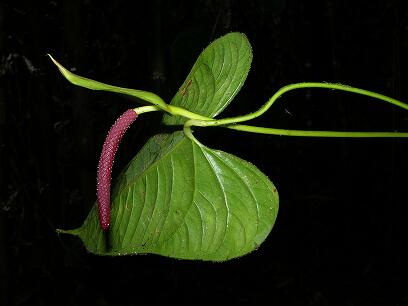Family: Araceae

Kingdom: Plantae Rank: Family Parent: Alismatales Status: Valid
Common Names:
- Aroid Family - English, United States of America
Vegetative Morphology
Habit: Herbs, terrestrial, epiphytic, hemiepiphytic, epilithic, or sometimes aquatic.
Main axis: Stems rarely erect, typically creeping, climbing, or scandent, subterranean or aerial, sometimes with rhizomes or tubers. Roots often aerial.
Leaves: Leaves alternate, simple, sometimes basal, the petioles often long, sheathing the stem at the base, the lamina variable, often cordate to sagittate, perforated in some species, the margins entire or lobed.
Exudate: Sap present, brown, milky, or transparent.
Reproductive Morphology
Inflorescence: Inflorescence terminal or axillary, consisting of a spadix subtended by a hood-like spathe, the spathe variable, surrounding all or part of the spadix or sometimes reduced to absent, white, green, to colorful; when flowers unisexual, the pistillate flowers are positioned at the base of the spadix and the staminate flowers at the apex.
Flowers: Flowers small, bisexual or typically unisexual on monoecious plants, sessile, 2-3-merous; tepals 4-6, rarely connate; stamens 3-9, free or united with androecium; gynoecium syncarpous, the ovary superior, sessile or immersed in spadix, entire or lobed, the carpels one to many, the locules 1-3 or more; placentation axile or parietal, the ovules one to many per locule.
Fruit: Fruit a berry, cylindrical to globose, often juicy, free along spadix or sometimes syncarpous, usually red, orange, or purple, sometimes white, yellow or green, rarely blue or brown.
Seeds: Seeds one to several per fruit, the testa thick or thin, smooth, rugose, verrucose or costate, striate, papiraceous, sometimes deciduous in the maturity or absent, rarely operculate; the endosperm abundant to absent.